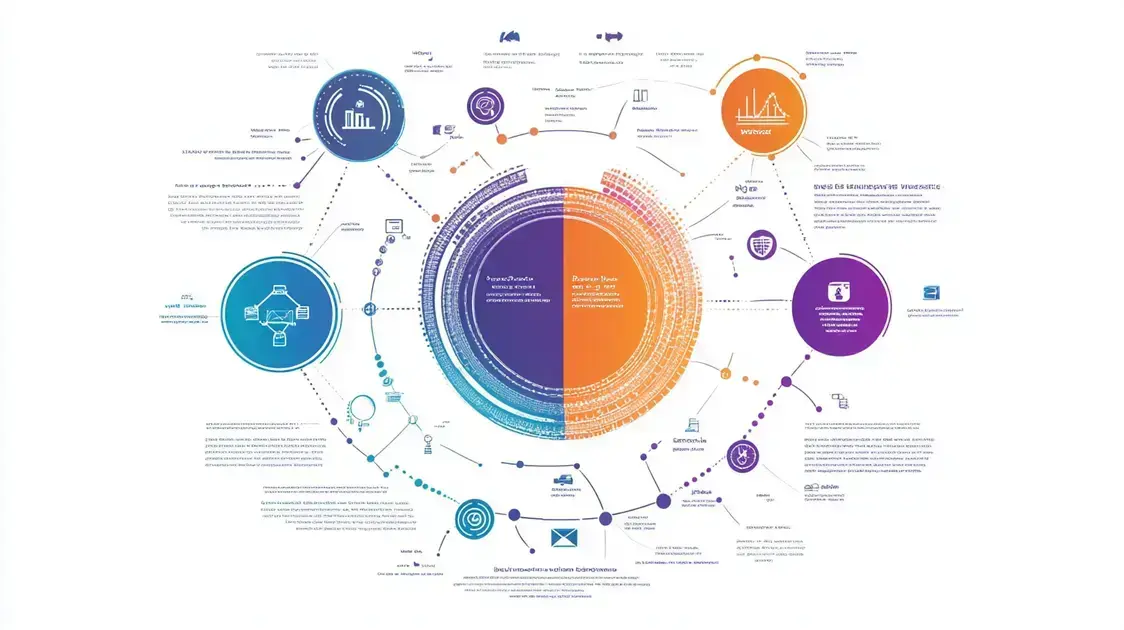Digital Transformation in Businesses is the process of integrating digital technologies into all areas of an organisation. This shift goes beyond simply adopting new tools—it requires a fundamental change in how businesses operate and deliver value to customers.
By using technologies like artificial intelligence, cloud computing, and data analytics, companies can optimise internal processes and make smarter decisions. These innovations allow for faster responses to market demands and better resource management, both of which are crucial in Digital Transformation in Businesses.
To stay competitive, it’s essential to embrace these changes and explore how they can transform your operations. Keep reading to discover how Digital Transformation in Businesses can unlock new levels of growth, efficiency, and customer satisfaction.
Understanding Digital Transformation
Digital Transformation in Businesses goes beyond adopting new tools—it’s about redefining how value is delivered to customers. It focuses on improving processes, enhancing experiences, and building a culture that embraces innovation. This approach helps businesses stay relevant in a fast-evolving digital world.
Agility is a key element of Digital Transformation in Businesses. Companies must respond quickly to market changes, using automation and flexible strategies to test ideas and adapt efficiently. Being agile allows businesses to remain competitive and innovative.
For lasting impact, Digital Transformation in Businesses must also prioritise people. Encouraging a customer-focused mindset, promoting innovation, and investing in digital skills ensures that technology works hand in hand with empowered teams.
Benefits of Digital Transformation in Businesses
Benefits of Digital Transformation in Businesses are numerous and can significantly enhance overall performance. One of the primary advantages is increased operational efficiency. By integrating digital tools, companies can automate repetitive tasks, which saves time and reduces errors. This allows employees to focus on more important and strategic activities.
Enhanced Customer Experience
Digital transformation also plays a crucial role in improving the customer experience. Businesses can use technology to provide more personalised services and faster responses. For example, data analytics can help understand customer behaviours and preferences, allowing for tailored marketing and enhanced service delivery.
Data-Driven Decision Making
With digital transformation, companies have access to vast amounts of data. This data can be analysed to gain insights and inform critical business decisions. Such data-driven approaches enable organisations to react swiftly to market changes, minimising risks and maximising opportunities.
Increased Collaboration and Communication
Digital tools foster a collaborative environment within businesses. Cloud-based applications and communication platforms ensure that team members can work together seamlessly, regardless of their location. This enhances teamwork and improves productivity across the organisation.
Improved Agility and Flexibility
In a fast-changing business landscape, agility is key. Digital transformation equips companies with the flexibility to pivot their strategies and operations as needed. By embracing new technologies, businesses can quickly adapt to changing market demands and stay ahead of competitors.
Furthermore, embracing new technologies promotes innovation within organisations. A culture that encourages experimentation and the use of cutting-edge tools leads to innovative solutions and products that can capture market attention.
Key Technologies Driving Digital Transformation

Key Technologies Driving Digital Transformation are essential for businesses looking to innovate and improve their processes. Understanding these technologies can help companies successfully adapt to the digital landscape.
Cloud Computing
Cloud computing offers flexibility and scalability by allowing businesses to store and access data over the internet instead of on local servers. This not only reduces IT costs but also enables employees to work from anywhere, facilitating remote collaboration.
Artificial Intelligence (AI)
AI is transforming industries by automating tasks, analysing data, and providing insights into consumer behaviour. Companies use AI to enhance customer service through chatbots and to streamline operations by predicting trends and optimising supply chains.
Internet of Things (IoT)
The Internet of Things connects devices and systems, enabling real-time data exchange. For example, IoT devices in manufacturing can monitor machinery performance and predict maintenance needs, thus reducing downtime and improving efficiency.
Big Data Analytics
Big data analytics allows businesses to process large volumes of data quickly and efficiently. By analysing this data, companies can gain valuable insights into customer preferences, market trends, and operational performance, leading to better decision-making.
Blockchain Technology
Blockchain enhances security and transparency in transactions. It enables secure sharing of information across networks, which is particularly beneficial for industries such as finance and supply chain. Businesses can track assets and ensure data integrity with blockchain solutions.
Augmented Reality (AR) and Virtual Reality (VR)
AR and VR technologies are reshaping customer experiences, especially in retail and training. Customers can experience products virtually, while employees can undergo immersive training simulations, improving engagement and effectiveness.
Incorporating these key technologies into business operations not only drives efficiency but also facilitates innovation and growth in the digital landscape.
Challenges of Implementing Digital Transformation
Challenges of Implementing Digital Transformation can be significant for businesses. Understanding these challenges is essential for a successful transition into the digital landscape.
Resistance to Change
One of the biggest challenges is resistance to change from employees and management. Many individuals are accustomed to traditional processes and might be hesitant to adopt new technologies. This resistance can slow down the progress of implementing digital solutions.
Lack of Skilled Workforce
Digital transformation requires a skilled workforce that is knowledgeable about new technologies. Many companies face a skills gap, making it difficult to find employees who can effectively implement and manage digital initiatives. Investing in training and development is crucial to bridge this gap.
Data Security Concerns
As businesses move to digital platforms, data security becomes a major concern. Cybersecurity threats can compromise sensitive information, leading to financial and reputational damage. Companies must ensure robust security measures are in place to protect their data.
Integration with Legacy Systems
Many organisations rely on older, legacy systems that may not easily integrate with new digital technologies. This can create challenges when trying to implement new solutions, as businesses may need to invest resources in upgrading or replacing outdated systems.
Budget Constraints
Implementing digital transformation often requires significant financial investment. Budget constraints can limit a company’s ability to adopt new technologies, hire skilled personnel, or conduct necessary training. A clear strategy and prioritisation of initiatives can help manage costs effectively.
Measuring ROI
Another challenge is measuring the return on investment (ROI) from digital transformation efforts. Companies may struggle to quantify the benefits of digital initiatives, making it difficult to justify the investments made. Establishing clear metrics for success is essential to monitor progress and outcomes.
By addressing these challenges proactively, businesses can position themselves better for a successful digital transformation and realise the full potential of the benefits that technology can provide.
Best Practices for Digital Transformation

Best Practices for Digital Transformation are essential for ensuring a smooth transition and successful implementation of new technologies in businesses. Here are several key practices to consider:
1. Set Clear Goals
Before embarking on a digital transformation journey, it is crucial to establish clear, measurable goals. Whether it’s improving customer experience, increasing operational efficiency, or boosting sales, having defined objectives will guide your strategy and keep the team focused.
2. Involve Leadership
Leadership buy-in is vital for successful digital transformation. Leaders should communicate the vision and importance of digital initiatives to promote a culture of change. Their involvement helps in securing resources and motivating the entire organisation.
3. Foster a Culture of Innovation
Encouraging a culture that embraces innovation and experimentation is essential. Employees should feel empowered to share ideas and try new solutions without fear of failure. This mindset can lead to valuable insights and a stronger commitment to digital initiatives.
4. Invest in Training and Development
As new technologies are introduced, ongoing training is necessary for staff to effectively use them. Investing in training programs ensures that team members have the skills and knowledge needed to leverage digital tools successfully.
5. Focus on Customer Experience
Customer experience should always be a priority during digital transformation. Businesses need to listen to customer feedback and understand their needs to create solutions that enhance interactions. Personalisation and convenience should be at the forefront of any digital strategy.
6. Use Data to Drive Decisions
Data analytics plays a crucial role in informing business decisions. Companies should collect and analyse data to understand trends, customer behaviour, and performance metrics. This insight allows organisations to make informed strategies that align with their goals.
7. Prioritise Cybersecurity
With increased digitalisation comes a greater need for robust cybersecurity measures. Protecting sensitive data should be a top priority. Implementing security protocols and training staff on best practices helps safeguard against potential threats.
By following these best practices, businesses can navigate the complexities of digital transformation more effectively, ensuring they remain competitive and adaptive in the ever-evolving market.
Future Trends in Digital Transformation
Digital Transformation in Businesses is evolving rapidly with technologies like AI, hyper-personalisation, and remote work tools becoming essential. These innovations help streamline tasks, improve customer experiences, and drive better decision-making across all sectors.
To stay ahead, companies must integrate tools like IoT, blockchain, and advanced cybersecurity into their strategies. These technologies are key drivers of efficiency and trust, making them critical components of successful Digital Transformation in Businesses.
Agility and innovation are now vital. Businesses embracing flexibility and quick adaptation will lead the way in Digital Transformation in Businesses, staying competitive in a constantly changing digital landscape.
Measuring Success in Digital Transformation
Measuring success in Digital Transformation in Businesses begins with setting clear, measurable goals. Targets like improving customer satisfaction, increasing revenue, or reducing costs help track progress and determine the effectiveness of digital initiatives.
Another vital part of evaluating Digital Transformation in Businesses is collecting feedback from customers and employees. Positive responses and engagement signal that changes are working. Data analytics and ROI tracking also offer insight into what’s performing well and where adjustments are needed.
Benchmarking against competitors helps assess overall performance. Comparing results reveals strengths and areas to improve. With these strategies, companies can ensure their Digital Transformation in Businesses delivers lasting impact and continuous growth.
FAQ – Frequently Asked Questions about Digital Transformation in Businesses
What is digital transformation?
Digital transformation is the integration of digital technology into all areas of a business, fundamentally changing how it operates and delivers value to customers.
What are the benefits of digital transformation?
The benefits include increased operational efficiency, improved customer experiences, enhanced data-driven decision-making, and greater flexibility and agility in adapting to market changes.
What key technologies drive digital transformation?
Key technologies include cloud computing, artificial intelligence (AI), the Internet of Things (IoT), big data analytics, and blockchain technology.
What are some common challenges faced during digital transformation?
Common challenges include resistance to change, lack of skilled workforce, data security concerns, integration with legacy systems, and budget constraints.
How can I measure success in digital transformation?
Success can be measured through clear objectives, customer feedback, data analytics, employee engagement, return on investment (ROI), operational efficiency reports, and benchmarking against competitors.
How can I foster a culture of innovation in my business?
Encourage employees to share ideas, empower them to experiment with new solutions, and provide training and resources that support innovation and continuous improvement.
Check out our article on Blockchain in Fintech to explore how this revolutionary technology is transforming the financial services industry.
